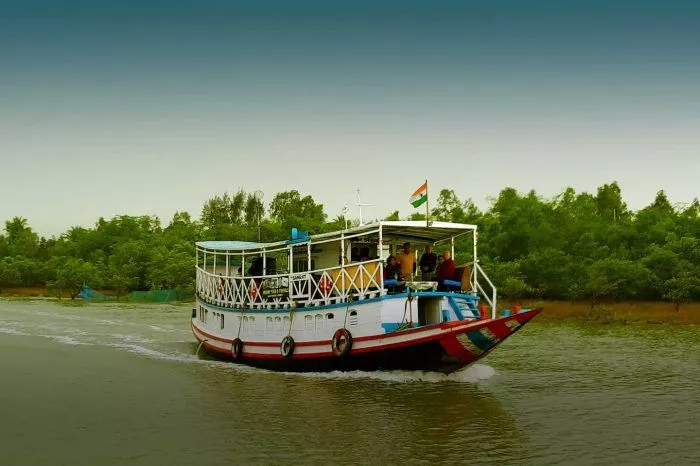- 1 Day Sundarban Tour
Pricing:
- ₹2799 per adult
- ₹1399 for children aged 4-8 years
- Free for children aged 1-4 years (under 48 months)
Facilities Included:
- Welcome Drink:
- Transportation: [Pick + Drop]
- Breakfast:
- Boat Safari:
- Lunch:
- Sightseeing:
- Guide Assistance:
- Snacks and Tea:
- Safety Measures:
- 1 Night 2 Days Sundarban Tour
Pricing:
- ₹4500 per adult (Non-AC room)
- ₹5000 per adult (AC room)
- ₹2250 for children aged 4-8 years
- Free for children aged 1-4 years (under 48 months)
Facilities Included:
- Welcome Drink
- Meals: All Times
- Boat Safari
- Accommodation: AC/ Non Ac
- Cultural Program:
- Visit Watchtowers and Local Attractions
- Safety
- Guided Tour
- Tea/Coffee Breaks
- 2 Night 3 Days Sundarban Tour
Pricing:
- ₹5500 per adult (Non-AC room)
- ₹6500 per adult (AC room)
- ₹2750 for children aged 4-8 years
- Free for children aged 1-4 years (under 48 months)
Facilities Included:
- Welcome Drink
- Meals: (breakfast, lunch, evening snacks, and dinner)
- Extended Boat Safaris: Multiple guided boat safaris
- Accommodation: in AC or non-AC rooms,
- Cultural Program:
- Visits to Key Attractions:
- Expert Guide:
- Tea/Coffee Breaks:

Sundarban 3 Days 2 Nights Package
Immerse in the wild beauty of Sundarbans with our 3 Days, 2 Nights adventure!

Book Sundarban 3 Days 2 Nights
Immerse in the wild beauty of Sundarbans with our 3 Days, 2 Nights adventure!
- 2 Night 3 Days Sundarban Boat Tour
Pricing:
- ₹5500 per adult (Non-AC room)
- ₹6500 per adult (AC room)
- ₹2750 for children aged 4-8 years
- Free for children aged 1-4 years (under 48 months)
Facilities Included:
- All Meals:
- Guided Boat Safaris:
- 2-Night Accommodation: Stay on the boat in comfortable AC or non-AC rooms.
- Cultural Performances:
- Attractions:
- Safety & Security:

Boat Sundarban 3 Days 2 Nights Package
Sail into the wild with our 3 Days, 2 Nights Sundarban Boat Adventure!

Sundarban 3 Days 2 Nights Package
Explore the untamed beauty of Sundarbans with a thrilling 3 Days, 2 Nights boat tour!
Sustainable Travel in Sundarbans: How to Minimize Your Impact

Introduction: Sustainable Travel in Sundarbans – How to Minimize Your Impact
Sustainable travel in Sundarbans is essential for preserving the delicate balance of this extraordinary mangrove forest and its diverse wildlife. As one of the world’s largest tidal halophytic ecosystems, the Sundarbans faces increasing environmental pressures from climate change, pollution, and tourism. Understanding how to minimize your impact while visiting is critical not only for protecting nature but also for supporting local communities who depend on these natural resources. This guide will walk you through the best practices for sustainable travel in Sundarbans, ensuring that your journey leaves a positive footprint.

Why Sustainable Travel Matters in Sundarbans
The Sundarbans ecosystem is home to endangered species like the Royal Bengal Tiger and the Gangetic dolphin. It also acts as a vital carbon sink and natural barrier against storms. However, unsustainable tourism and human activity can lead to habitat destruction, water pollution, and disturbance to wildlife.
Environmental Challenges:
- Deforestation and mangrove degradation
- Water contamination from waste
- Disruption of wildlife due to noise and proximity
- Increased mosquito populations due to stagnant water and pollution
By adopting sustainable travel methods, visitors can help reduce these negative impacts and contribute to conservation efforts.

How to Minimize Your Impact: Sustainable Travel Tips for Sundarbans
1. Choose Eco-Friendly Accommodations and Tours
Opt for lodges and tour operators that follow sustainable practices such as waste management, renewable energy use, and community involvement. These operators often educate visitors on environmental issues and wildlife behavior.
2. Reduce Plastic Use and Waste
Carry reusable water bottles, bags, and containers. Avoid single-use plastics and ensure all waste is properly disposed of or taken back with you, as the Sundarbans’ fragile environment cannot absorb excess garbage.
3. Respect Wildlife and Natural Habitats
Maintain a safe distance from animals and avoid feeding them. Follow designated trails and boating routes to minimize habitat disturbance.
4. Use Environmentally Safe Products
Choose biodegradable soaps, insect repellents, and sunscreens to avoid polluting waterways.

5. Limit Noise and Light Pollution
Keep noise levels low during tours, especially near wildlife habitats. Use minimal artificial lighting at night to reduce disruption to nocturnal animals.
6. Stay Safe from Mosquitoes While Respecting Nature
Use mosquito nets and repellents responsibly to protect yourself from insect-borne diseases without harming the ecosystem.
Additional Sustainable Travel Practices to Consider
- Travel during off-peak seasons to reduce overcrowding and pressure on resources.
- Support local artisans and businesses to boost the community economy.
- Participate in volunteer programs or conservation initiatives when possible.
Read More:

Long-Tail Keywords to Naturally Include
- Eco-friendly Sundarbans travel tips
- How to travel sustainably in Sundarbans
- Minimizing environmental impact in Sundarbans tourism
- Responsible wildlife tourism in Sundarbans
- Sundarbans mosquito safety tips for travelers
Internal and External Link Suggestions
- Internal Link Suggestion: Link to an article on How Eco-Tourism is Shaping the Future of Sundarbans for readers interested in deeper sustainable travel insights.
- External Link Suggestion: Link to recognized environmental organizations working on Sundarbans conservation or sustainable tourism certification bodies.

Conclusion: Travel Responsibly and Protect the Sundarbans for Future Generations
Sustainable travel in Sundarbans means more than just visiting—it means actively protecting and respecting this unique ecosystem. By minimizing your impact, you help conserve critical habitats, support local communities, and preserve the Sundarbans’ natural beauty for generations to come.
Ensure your visit is safe by taking precautions to stay safe from mosquitoes while enjoying the rich biodiversity.
Also, you can Book the Sundarban Tour At Royal Sundarban Tourism [https://royalsundarbantourism.com/] Powered By Argusdna, [https://argusdna.com/] for a sustainable, well-organized, and responsible travel experience.
Make your journey a part of the solution—choose sustainable travel in Sundarbans today.








